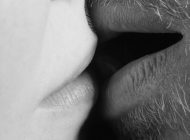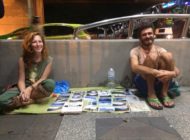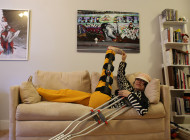It’s ‘color’, not ‘race’
I was sitting near a mother of two young sons in Manila. I could tell when looking at her children that their father was white, as both boys looked Eurasian. She was inquisitive about my skin color, and was wondering were I was from, so we struck up a conversation. I mentioned briefly that my mother was Filipina, and that my dark coloring was from my father of Southern Indian origin.
“The lady then pointed to one of her sons, and said that he was the ‘dark’ one of his family.”
It was not very obvious at all and he looked exactly the same as his brother, except his hair was just a darker shade of brown.
This is a common interaction in the Philippines. People mention color in a way which is not common in the west—‘darkness’ and ‘lightness’ are relative terms, marking differences of color between people, even between family members. Even though people in the Philippines are aware of the racism that occurs in western countries, and Filipinos who live in the west realize that they inhabit a system of race where to be Filipino is to be categorized as being non-white or brown, they believe that no problem with ‘race’ exists in their society.
“Instead, the situation in the Philippines manifests more subtly as a ‘color’ problem.”
The discourse of color is spoken and demarcated differently than systems of race in places like the United States, with terms such as ‘fair’, ‘light’, and ‘dark’ making more sense than ‘white’ or ‘black’.
Color as relational, not absolute
From a young age I was already entrenched in the color scale of the Philippines. I remember when I was young my maternal grandmother would continuously tell stories of her mother who was half Irish-American. A common compliment from my grandmother would be:
“You’re so beautiful; you look like your great-grandmother, only a ‘darker’ version.”
Usually, when Filipinos make a comment about the beauty of someone who is considered ‘light’ there is no comment about their skin tone. This is in contrast to the narrative when complimenting someone who is seen as being ‘dark’, when people first need to qualify that the person is a ‘dark beauty’. In this, the default cultural conception of beauty is light skinned–although darker tones can be beautiful, they require more justification. In the Philippines anything which can make one look fair or feel fair is desired and wanted, while rituals which reinstate darkness, such as tanning, are shunned. Thus, people are trying to make themselves feel fairer than everyone else. In the Filipino context, color terms are mostly relational.
Identity categories are linked to cultural ideas as well as physical attributes. The term ‘mestizo’ originally applies to people who are of mixed indigenous and Spanish descent. However, Filipinos who have any western blood in their family gene pool would usually refer to themselves as ‘mestizo’. The expression ‘moreno’ is used to describe the dark hair and brown skin of the Malay majority. However, one friend would insist that she was of ‘mestiza’ (mixed-white) descent even though she looked more ‘Malay’ than other friends. People consider her to be ‘mestiza’ as she was able to speak Spanish and was from a prominent Filipino family with known political connections.
This is a system of categorization that, while linked firmly with ancestry and descent, is much more flexible than we see in the west. Two friends who identify themselves to be ‘mestiza’ were categorized as being ‘morena’ when they went to the States; they said that
“it doesn’t matter to white Americans, they look at us and all they see are two brown girls.”
They realize that when they are in the Philippines they are considered to be ‘fair’ yet when they go to a Caucasian country their skin tones are labeled as ‘dark’. Their categorization depends on the context. When they are abroad their Filipino features mark them to be people with less monetary value, yet when they return home their ‘mestiza’ complexion classifies them as having access to wealth.
Fairness and colonialism
Access to fairness in third world countries such as the Philippines is a limited good, and the poverty which is associated with being dark is “the absence of that good.
“The discourse of color that one finds in the Philippines is reinstating the history of colonialism and reinforcing the old prejudices of Spain and America, where being white meant that one was the ruler, and being brown meant that one was a slave.”
Overall, executives have lighter skin than their drivers, maids, or personal assistants. People who are dark-skinned and light-skinned live and inhabit different strata of society, and if one is considered ‘fair’ in Filipino society one has a higher chance of bettering oneself materially in comparison to someone who is considered ‘dark’.
“In essence, these color relations are in fact power relations.”
In the political color economy of the Philippines, one’s worth as a person is determined by relational connection with the terms of light or dark. This is stated in the most explicit economic sense in Cynthia Enloe’s book Bananas, Beaches and Bases: Making Feminist Sense of International Politics, in which she writes out of the 30,000 children born each year of Filipina Prostitutes and American soldiers, when the US Army had a base in the Philippines, 10,000 end up on the street or themselves being sold to pedophiles. Enloe (2000) states that “those Caucasian-looking children each allegedly sell for 50-200 US dollars, whereas the negro-fathered ones fetch only 20-25 US dollars” (p. 87). The legacy of colonialism is still being felt in the daily power plays of darkness versus lightness.
As with all colonized countries, the legacy and impact of colonialism puts color into discourse in delicate and clever ways. In countries such as United States and Britain the concept of race is clear cut and definable. It is enshrined in the law books, and in the United States it is embedded in the constitution. In the Philippines, race has no appearance in the structure of society, but is played out against tonal differences, which depend on the context.
“Discrimination based on color plays out through gestures between people, as everyone tries to get his or her hand on the commodity that is fairness or lightness.”
The history of conquest helped to create this system of signs that demarcates dark-skin as being subordinate to light-skin. It was white-skinned people who twice colonized and enslaved the Philippines, cementing the ideological system that led my grandmother to qualify that I was beautiful like my ancestor, only a ‘darker version’.
Tags: beauty colorism feminism gender identity inequality Philippines race
























1 Comment
Beautifully articulated Monica!
The running narrative of Masters and slaves have been inculcated in the psyche of the Filipinos and so as the western society.
In distinguishing the spectrum of colours one wear on their outer skin, one can’t remove themselves from singing the same songs that became a constant hymn of a nation.
It is regrettable that the colonized mind has not emancipated itself from this predicament which then seed itself to prejudice and judgement.
The fact that most individuals wear a camouflage in order to belong or be accepted is an indictment of how culturally immature we are as human beings, thus, giving ample ways to elements of false pride and belief. The camouflage is a self-prescribed battle gear in order the survive the battlefields of human condition, us and them, rich and poor, white and colored etc. And the ones who become triumphant in this endeavor are the individual guerilla warriors of life and light whose recognition of color matters only to what is underneath the surface.
Thank you for this article..
Mannix